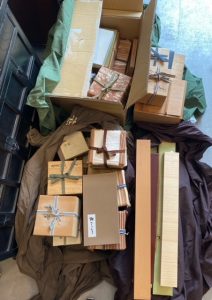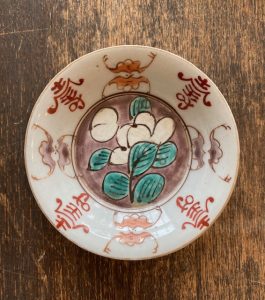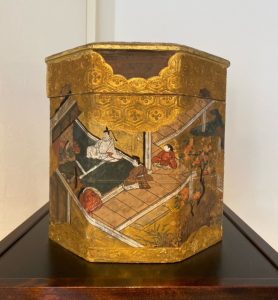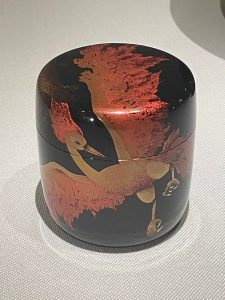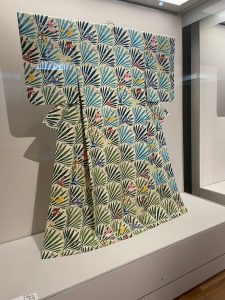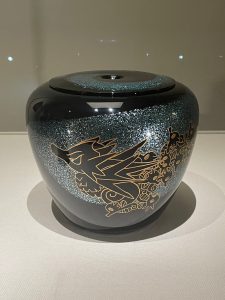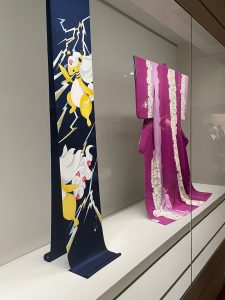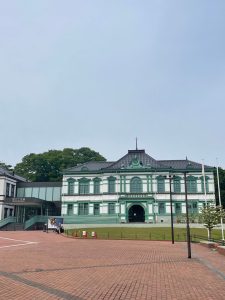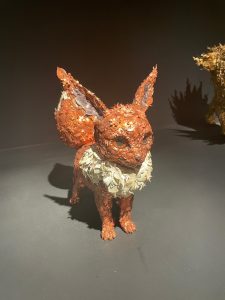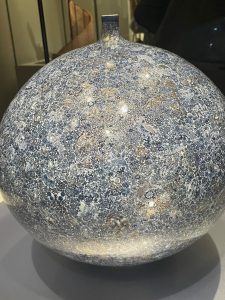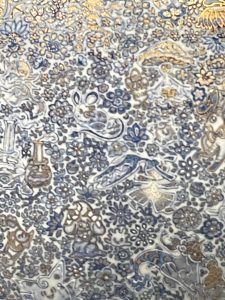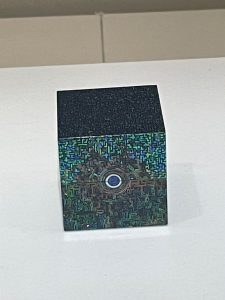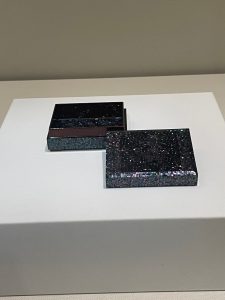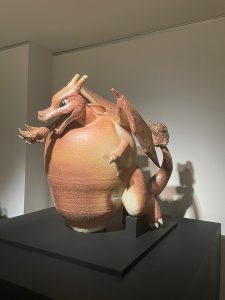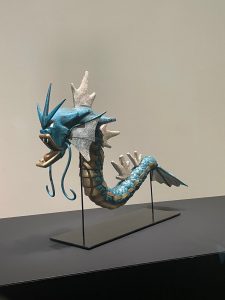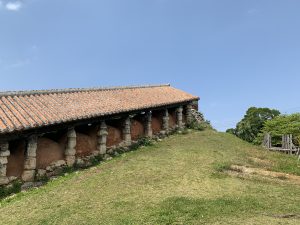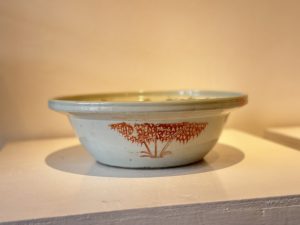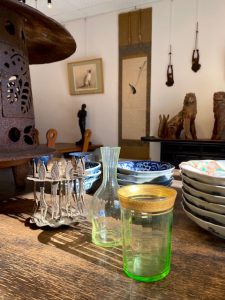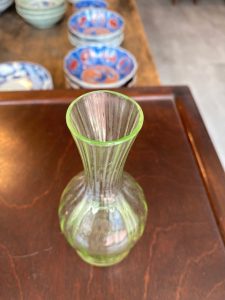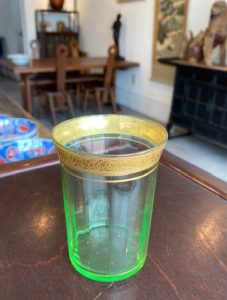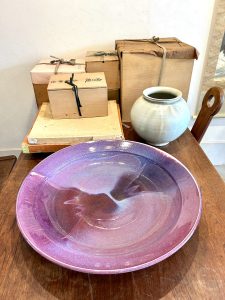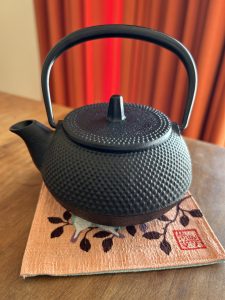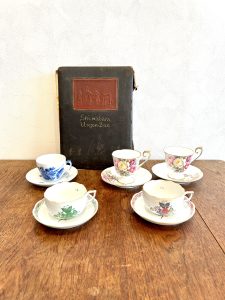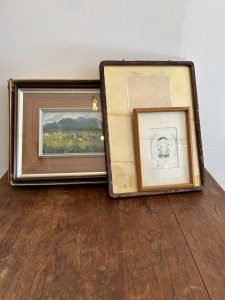皆さまこんにちは。スタッフHでございます。
梅雨の晴れ間の青空が鮮やかですね。
さて、普段はあまり衝動買いをしないのですが、たまに衝動に負けてしまいます。
結果後悔することも多いのですが、まれに我が家での愛用品となります。その一つがこちらの「中津箒」です。

数年前、デパートの特設会場で出会いました。
実はお目当ての品があったのですが、箒のコーナーに吸い寄せられてしまいました。
私がしげしげと眺めていると、職人さんが中津箒について説明してくださり、気づくと既に買う気満々で、どれにしようか迷っている状態でした。
まさに衝動買いです。
中津箒は明治時代に神奈川県旧中津村(現藍川町愛川町)で生まれた箒です。
今では人気の中津箒ですが、その伝統が途絶えた時期がありました。
昭和30年代、電気掃除機の普及や海外の安価な製品の流入により箒産業は衰退。
しかし2008年、まちの文化として箒づくりを盛り上げようという動きがあり、若い人たちも加わって復活したということです。
原料であるホウキトウモロコシも無農薬で自社生産し、一つ一つ職人による手仕事によって作られました。
世に多く出回っている箒は、穂体(掃く部分)の先を揃えるため、1番柔らかい穂先を切ってしまいますが、中津箒は、なるべく穂先を残すよう長さや太さごとに選別し、丁寧に揃えられているので、柔らかくコシのある滑らかな掃き心地が特徴です。

桜の枯れ葉や山ぶどうの枝の皮などを使って、自分たちで染めた糸などで束ねられています。
畳でも床でも当たりが柔らかく、埃を優しく掃き出してくれる感じがします。
見た目も美しいので、壁に吊るしたり立てかけたままでも目の保養になるので出しっぱなしです。
電気も使わず静かなのが何より気に入っています。
使うほどに穂先がすり減ってきますが、少しずつその穂先を整えたら短くなるまで10年~20年
は使えるとのことです。
これを機にほうきの歴史についても調べてみました。
ほうきは歴史を遡ると古墳時代から存在していたと言われています。
奈良時代のあたりまでは、掃除道具というより、神事に使われる道具でした。
ほうきで「掃う(はらう)」は「祓う(はらう)」につながり、邪気を払い、悪いものを追い出す意味があったようです。
やがて平安時代になると、ほうきは掃除道具としても使われるようになります。
海外からの旅行者が日本の街の清潔さに驚くという話をよく聞きます。
確かに日本人は清潔好きなのかもしれませんが、それは衛生的な生活を維持するためだけでなく、「清める」という意識とつながっているのかもしれません。
神社に入る前には手を洗い、口をすすぎ、身を清めて神様の元へ向かいます。
仏教では掃除は一種の瞑想としても説かれ、床を磨き、庭の掃除をすることは心を磨くことであり、修行の一つとされています。
茶道においても茶碗、茶匙、棗など繰り返し「清め」の所作が作法に組み込まれています。
日本人には見慣れた光景ですが、外国の方は不思議に思うかもしれませんね。
さて先ほどの中津箒、手に馴染む一本を選び、購入したところで思い出しました。その日は電車できていたことを…。しかも包装は小さな紙をこるっと巻いただけ。箒を抱えて電車に乗り込むという初めての体験をすることになり、訳もなくソワソワしてしまいました。
あれから数年、すっかり部屋の定位置に収まっています。
それでは、またお会いしましょう。
Hello everyone. This is Staff H.
The blue sky during a break in the rainy season is so vivid.
Now, I don’t usually make impulse purchases, but sometimes I give in to my impulses.
I often regret the result, but on rare occasions, it becomes a favorite item in my home.
One such item is this “Nakatsu Broom”.
I came across it several years ago at a special exhibition in a department store.
I actually had an item in mind, but was drawn to the broom section.
As I gazed at the brooms, a craftsman explained about Nakatsu Brooms to me, and I found myself already ready to buy one, trying to decide which one to choose.
It was truly an impulse purchase.
The Nakatsu Broom was born in the former Nakatsu Village (now Aikawa Town, Aikawa Town) in Kanagawa Prefecture during the Meiji Era (1868-1912).
Although the Nakatsu Broom is popular today, there was a time when its tradition was discontinued.
In the 1950s, the broom industry declined due to the spread of electric vacuum cleaners and the influx of inexpensive foreign products.
In 2008, however, there was a movement to revive broom making as a part of the town’s culture, and young people joined in the revival.
The broom corn used to make brooms is produced in-house using no pesticides, and each broom is made by hand by craftsmen.
Nakatsu brooms, however, are carefully sorted by length and thickness to leave as many tips as possible, so that they are soft, firm, and smooth.
They are bound together with dead cherry leaves, bark of mountain grape branches, and other materials such as threads that they dye themselves.
It feels soft against both tatami mats and floors, and gently sweeps away dust.
They are also beautiful to look at, so we leave them out hanging or standing on the wall as they are a feast for the eyes.
I like it best of all because it uses no electricity and is quiet.
The more I use it, the more the tip wears off, but if I trim the tip little by little, it will last 10 to 20 years before it gets too short.
I took this opportunity to look into the history of brooms.
I took this opportunity to research the history of brooms.
It is said that brooms have existed since the Kofun period.
Until around the Nara period (710-794), it was a tool used in Shinto rituals rather than a tool for cleaning.
The word “sweep” with a broomstick is connected to “purify” (harau), and it seems to have had the meaning of dispelling evil spirits and expelling bad things from the world.
In the Heian period (794-1185), brooms came to be used as cleaning tools.
We often hear that travelers from overseas are surprised at the cleanliness of Japanese cities.
It is true that Japanese people may like cleanliness, but this may be connected not only to maintaining a hygienic lifestyle, but also to a sense of “purification.
Before entering a shrine, people wash their hands, rinse their mouths, and purify themselves before going to God.
In Buddhism, cleaning is also taught as a kind of meditation, and polishing the floor and sweeping the garden is considered to be a form of training, as it is a way of refining the mind.
In the tea ceremony, the act of repeatedly purifying tea bowls, tea spoons, and jujubes is also a part of the ritual.
Japanese people are used to seeing this, but foreigners may find it strange.
I remembered that I had just purchased a Nakatsu Broomstick when I chose one that felt comfortable in my hand. I was on a train that day. And the wrapping was just a small piece of paper wrapped around the broom. I was so nervous for no reason, as it was my first experience to board a train with a broom in my arms.
A few years have passed since then, and the broom is now in its permanent place in my room.
I hope to see you again soon.
*******************
ご実家の整理やお片付けなどをされている方のご相談などが多くございます。
お片付けなどくれぐれもご無理のないようになさってくださいませ。
風光舎では古美術品や骨董品の他にも絵画や宝石、趣味のお品など様々なジャンルのものを買受しております。
お片付けをされていて、こういうものでもいいのかしらと迷われているものでも、どうぞお気軽にご相談下さいませ。
また風光舎は、出張買取も強化しております。ご近所はもちろん、愛知県内、岐阜県、三重県その他の県へも出張いたします。
まずは、お電話お待ちしております。
愛知県名古屋市千種区姫池通
骨董 買取【古美術 風光舎 名古屋店】
TEL052(734)8444
10:00-17:00 OPEN
#出張買取#骨董#古美術#骨董品#絵画#版画#茶道具#刀剣#彫刻
